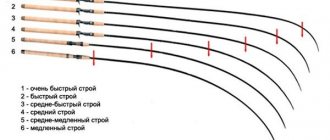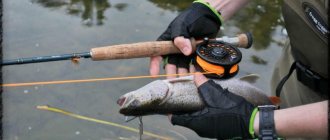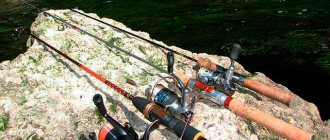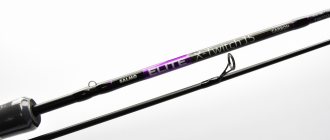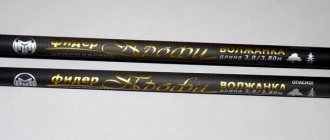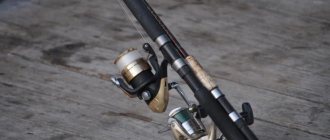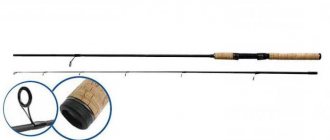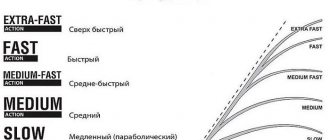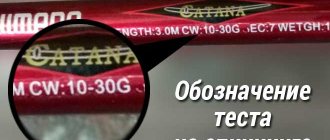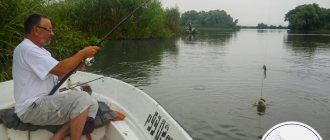What does a spinning test mean?
Spinning rod test – boundaries (limits) of lure weight. If, if the lower weight threshold is violated, the cast will be less accurate and farther, then if a heavier bait is used, there is a possibility of damage to the rod blank, even to the point of breaking it.
Spinners know that sensitivity is a highly informative indicator. If the “bait-test” ratios do not match, the movement of the spoon (touching the bottom, obstacles, bite) will not be transmitted to the rod. As a result, actions will be taken at random, which reduces the effectiveness of the entire event.
Decoding the test on the spinning form
The range of weight units (test/casting) is marked on the butt.
This parameter is often indicated in grams and looks like this:
casting wt. 1-6g or section 2 casting weight 1-6g.
This means that the rod is designed to handle baits greater than 1g but less than 6g.
Some manufacturers write weight in ounces (oz), this mainly applies to American “sticks”.
For example, 1/32-3/16 oz - test in the range of 0.875 to 5.25 g .
(There are 28 g in one ounce)
We perform mathematical calculations:
- Divide 1 by 32 and multiply by 28.
- Next, we calculate the upper limit, divide 3 by 16 and multiply by 28.
The result of the actions is indicated above, this is the weight range of the baits - test.
What does a spinning test by bait weight mean?
Casting or lure weight test means that the rod is designed to be sensitive to lures in the specified range.
If this range is between 5g and 20g, then the optimal bait weight will be 12.5g.
This means that with this indicator the most accurate casting is possible and all the actions of the bait, at the time of retrieving, will be transmitted through the rod to the spinning rod.
There is such a thing among fishermen as a real test.
These readings also differ from the indicated values and are calculated as follows:
- Upper limit. To the average (optimal) value, the minimum indicator specified in the characteristics is added, in this case it is 5 g, 12.5 + 5, we get 17.5 g.
- The lower limit is calculated in the same way, but using subtraction, that is, 12.5-5, a result of 7.5 g will be the real lower limit of the test.
It turns out that the optimal weight of the bait is in the range of 7.5-17.5 g, with the specified parameters 5-20 g.
What is a line test?
In addition to matching the rod test and the weight of the bait, the diameter of the fishing line is also important. If the bait exceeds the characteristics of the spinning rod or you are lucky enough to seduce a trophy predator, then the likelihood (if fished incorrectly) of damage to the rod increases.
You can prevent gear breakage by choosing the appropriate fishing line. Therefore, the fishing line is selected according to the strength of the fishing rod, that is, it must withstand a load higher than that at which the fishing line breaks.
Most manufacturers overestimate the breaking limit, and the line breaks from forces 1.5-2 times less than stated. Almost every fisherman has this experience. It is worth noting that for braided material the characteristics are indicated more precisely.
Each tackle can be checked independently. The easiest way to determine the strength of a fishing line is to create a load and measure its limit.
One option is “a bucket under the tap”. One end of the fishing line is attached to an electronic scale, and a bucket is tied to the other end, into which water is constantly poured with equal intensity. At the limit of strength, the fishing line will break. The rupture indicator is recorded, and the experiment is repeated at least twice.
After such a check, you will be absolutely sure what weight the fishing line is designed for.
The fishing line changes its characteristics over time (15-20 fishing trips), especially if it is stored in the cold in winter. Therefore, it is better to open each season with a new fishing line and change it periodically if it is used frequently in work.
Manufacturers test gear and record the results in a characteristics form (Line test). Record the readings on the rod form using the abbreviation lb (feet) or kg (kilograms).
What does a rod test affect?
If you choose the wrong rod test, the consequences can be very different. If you choose a rod whose test is greater than the expected weight of the bait or equipment, then you simply will not be able to fish comfortably with it, since casting light tackle with a powerful rod will be complicated. If, on the contrary, you choose a rod that is too light and use baits for fishing with it, the weight of which significantly exceeds its test weight, then the consequences can be very sad, namely, if you cast too sharply, the rod may not withstand the critical load and break.
The influence of the test on the strength of the rod
The rod test affects its strength. It must be remembered that even when catching large fish with light equipment, for example, catfish with a mouse, which will float down the river, it is necessary to use a spinning rod with a dough of at least 40–80 grams, although in fact casting is not needed here, since the bait will simply go over the side of the boat, but the test is also important when landing fish. If your rod does not have the necessary test, then it will not withstand the powerful jerks of the catfish, and may also break. When choosing a fishing rod, it is very important to correctly determine its real test, unfortunately, this comes with experience, so if you want to choose the right fishing rod according to the test, it is better to take with you an avid fisherman friend who will cope with this task well.
donka.by
How to determine the spinning test if there is no marking
This question is asked by both beginners who are seriously interested in fishing, and experienced fishermen, holding a whip in their hands, either with or without a marking.
The fact is that the manufacturer often takes insurance and the test is deliberately underestimated in order to avoid its breakdown when casting a heavy bait.
Therefore, it is always better to determine the spinning test yourself, focusing on the markings, if they are present.
Beginners often reason in such a way that if a spinning rod is thin, then it is easy to break, but a thick one is reliable. But few people think that not only strength is a condition for successful and efficient wiring.
First of all, you can’t force a thick stick to make a long cast with small bait. Moreover, a light spoon will not be felt at all in the wiring, and if a small predator sits on it, the bite may not even be felt.
Expert opinion
Vladimir Poltoranin
Fisherman - expert
If you take a fishing rod and alternately throw different baits with equal force, starting with the lightest one, then the casting distance and accuracy will vary.
The range of tested baits should be quite wide, ranging from 1g to 40g.
Let's assume that the farthest baits were from 20 to 30g. This will be the casting of the rod.
This means that the average, optimal weight corresponds to 25g.
Why does it turn out that even by increasing the weight of the bait, it does not fly further than the lighter one and vice versa?
The rod has a certain elasticity and springiness. At the beginning of the cast, during the swing, under the action (resting inertia) of the bait, the tip of the rod bends back, after a jerk and redirection - forward.
This creates the effect of a shot.
In the case when, for the selected rod, the bait “goes” beyond the lower weight threshold, then there is no deviation back and no additional acceleration follows, as with springiness.
If the bait is heavier than the rod is designed for, then, even with a significant deviation back, the elasticity will not be enough to continue casting, that is, the additional impulse will be “extinguished” by insufficient rigidity.
If a light spinner (below the test value) is most likely not cast at the required distance, then exceeding it may result in breakage of the rod.
But even when throwing a lighter load, deformation of the gear is possible. This happens due to the desire to throw further light weight and a stronger and sharper “send” of the bait, which can cause damage.
Classification of spinning rods by test
In addition to the rod test instructions, there are also classification parameters:
- UL – ultra-light rod . Lures in such gear are used from 0.1g to 7g. Line with a diameter of 0.06 to 0.10 mm. This gear is suitable for hunting small and medium-sized fish, but under certain conditions you can fish for specimens up to 7 kg.
- L – light rod . The bait for this class can be used from 2g to 15g. The optimal fishing line size is from 0.13 to 0.2 mm. When working with this class of rod, you can experiment by adding a few grams to the weight, determining the maximum weight experimentally.
- ML – medium-light class rod . Bait weight from 5 g to 20 g.
- M – middle class rod . The most popular option among anglers. The weight of bait for this class is from 10g to 30g. Considering the high demand for just such “sticks,” bait manufacturers produce the most of them in this weight.
- MH – medium-heavy rods . This is the choice of those who know where the trophy “sits”. And he sits at a depth that can only be reached on board a ship. This gear is specially designed for fishing from boats (trolling). The rod is designed for baits up to 40g, and the lower weight of the bait is 15g.
- H – heavy rod . For fishing, baits from 20g to 50g are used.
- XH – super heavy class of rods . Durable material and high rigidity are designed for baits over 42g.
Manufacturers generally offer three running sizes - light, medium and heavy. Some manufacturers have no intermediate classifications at all.
Compliance of the test for the weight of bait and fishing line with the class of a spinning rod
As we have already seen from the information presented above, you can find out the test from the marking of the rod on the tackle form or in its passport. Based on the recommendations, it is worth selecting bait and fishing line with the optimal diameter. For ultra-light and light tackle, monofilament fishing lines and baits in the form of small silicone and zero-numbered rotating spinners are more suitable.
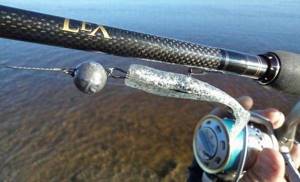
The medium and medium-heavy class of spinning rods work best on thin braided cords with different types of wobblers, oscillating spinners and most types of medium and heavy silicone baits. The heavy and extra-heavy class of gear is applicable in tandem with thick cords and deep-sea massive wobblers. When deciding on the purchase of gear, it is worth highlighting the main list of baits used in fishing and the focus in obtaining a trophy. After all, baits, lines and the power of the gear reflect the main aspects of fishing that contribute to the ultimate achievement of the goal - the effectiveness and success of fishing.
Which spinning test to choose
No matter what bait the fish is caught with, no matter where the predator is, the prerequisites for almost all types and types of fishing are the correct selection of gear.
The spinning test recommended for jigging must correspond to the weight of the bait. The test is indicated on the form, the measurement is ounces and grams.
For example, ¼ - 1 ¼ oz (ounces) would correspond to 7-35g (grams).
River fishing from the shore often involves jig fishing. If the shore is sandy and deepens smoothly (without an edge), there are no thickets on it, then it is more convenient to cast with long sticks, about 3 meters. A successful test is 15g for perch and 22g for pike and pike perch habitats.
In conditions of a steep coast, where there is vegetation and snags, the optimal length of the form will be about 2 meters. There are no special changes regarding the test, perch 15g, pike 22g. The optimal system is medium-fast.
Large bodies of standing water require long casts. For this, medium-length rods with a dough weight of up to 20g are suitable.
A stick with a fast action, which allows you to establish contact with the predator during the retrieve, works better in such conditions.
A heavy load in a stagnant body of water sometimes scares away a predator.
Small ponds also attract predators. The thickets of mud, water lily, and reeds provide a good breeding ground for a variety of small fish. With good nutrition, the predator grows well. Fast action, up to 2 meters long will be a convenient tackle.
A large test on such a lake is not needed, the upper limit of 15g is enough. A fisherman with a spinning rod in front of a puddle with reeds looks somewhat comical, but when a worthy specimen is caught, the situation changes radically.
They fish from a boat with gear no longer than 2.5 meters, usually 2 meters is enough. The boat test cannot be set to a specific limit.
The choice of bait range depends on the nature of the reservoir. Standing reservoirs – about 20g. Rivers with slow and medium flows - at least 25g; for fast flows and great depths, about 50g is possible.
In thickets, it is better to take about 25g of test from a boat, it will help drag the catch through the algae.
Trolling – you should choose rods with a test weight of about 50g, or even more. In such conditions it is good to “kill” Chinese “crocodiles”. With such a stick you can reach a predator along with the shelter.
Practical advice
Infrequently, but there are still cases when fishermen are faced with a problem: how to determine the test of a spinning rod if there is no marking on it . This question may arise, for example, when while fishing you have to use someone else’s form, without markings. Or after repairing the rod, associated with gluing or replacing one of its legs or tip. In this case, as is known, the characteristics of the form change somewhat.
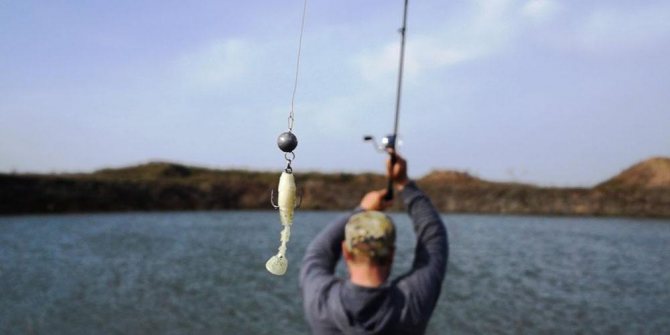
There is a proven way to determine the spinning test at home or on a pond. It is based on the shock-absorbing properties of modern fishing rods and consists of the following stages:
- Equip the form with a reel with thin fishing line that is convenient for you.
- Prepare several weights of different weights, which, in your opinion, approximately correspond to the test characteristics of this form.
- Next, you need to cast these loads, starting with one of the lightest. The casting technique should be identical for all attempts.
- It has been verified that at first, with an increase in the weight of the thrown load, the casting distance also increases. As soon as it is noticed that the casting range with the next load has stopped increasing, or even decreased, the experiment should be stopped and the weight of the penultimate load should be designated as the upper test value of this rod.
- The lower test limit is determined in the reverse order - it is necessary to reduce the weight of the load with each subsequent cast. As soon as the casting distance and the bite of the rod drop to their maximum, remember this weight as the lower value of this indicator.
When performing this test, it is important that you have a good feel for the rod and that each cast is made comfortably, without tension.
How to check the spinning test
You can check the test, with the markings indicated on it, using baits in this range and weighing less than specified. With a decrease in weight, the bait will feel bad when casting, and the casting range and accuracy will be significantly less effective. If you install a heavier bait, the spinning rod will most likely break.
To carry out a casting test, it is best to use an area with markings where you can measure the distance. With the same data, the weight of the bait changes and the distance where the bait flew and the accuracy of hitting the intended point are measured.
The sensitivity test determines the limit of the minimum weight of the bait, the movement of which in the water can be transmitted by the rod. During the test, baits with a minimum weight or slightly below it are thrown. As soon as the angler stops feeling the play of the spinner (the jig hitting the bottom), then the limit has been determined.
Recommendations for choosing a test form
Experienced fishermen always select a spinning rod according to the test in accordance with the baits that they have at their disposal, which they are already accustomed to using. Also, the size and weight of the prey that you can catch will largely depend on which spinning test you decide to choose.
Expert opinion
Knipovich Nikolai Mikhailovich
Zoologist, hydrobiologist. I am interested in fishing at a professional level.
Important! When choosing a fishing rod, it is very important to take into account its other parameters: length and action. Only with the correct combination of all the important characteristics can you fully experience what a spinning test is and how important it is.
For example, a spinning test for small pike , as already indicated, should start from 10 grams . The weight and size of the possible bait and, consequently, the effectiveness of this fishing gear depend on which test you choose for a spinning rod that is supposed to be used for catching large pike. For such fishing, it is recommended to take forms with this parameter from 25 g and above.
It is clear that the test values of a fishing rod for catching, for example, salmon or catfish, should belong to the heavy or even super-heavy class.
How to increase the spinning test
Increasing or decreasing the spinning test is the same as increasing the lower or upper weight limit. Theoretically, you can try heavier or lighter baits in the performance of the selected rod.
Some anglers advise removing the tip (part of the tip, changing the tip to another, more elastic one) in order to increase rigidity, and therefore the dough.
If the goal is to increase sensitivity, then a different technique is used. On the form, in the place of the longitudinal strip (connection), in the middle, where the reel seat is attached, a hole is made with a drill, 5-6 mm in diameter.
Drilling technology involves a manual process, that is, we hold the drill with our hand and turn it. You must first tap the drilling area. In some places there may be sealing elements that do not need to be disturbed.
The purpose of the procedure is to connect the blank to the reel seat with wire material. It is most convenient to use two-component, cold welding. The hole is sealed by welding so that the rod body is in contact with the reel seat. This simple technique significantly increases the sensitivity of mid-budget spins.
How to convert a spinning rod test in lb to grams
The test can be seen on the spinning form. It is denoted by the word Line, followed by values, where the limit is the breaking weight of the line or the force at which the rod may not withstand.
For example, on the form the inscription line 5-14lb indicates that for this rod the optimal line test is from 5 to 14 feet.
We are more familiar with weight units expressed in kilograms, so we convert lb to kg.
One foot is equal to 0.46 kg, multiply the values 5 x 0.46 = 2.3 and 14 x 0.46 = 6.44.
These values indicate that if you use a fishing line with a strength of less than 2.3 kg, then it is likely to break when casting. If you neglect the upper limit and give a load of more than 6.5 kg, the rod may break.
It is correct to choose the fishing line based on the average value, in this case it is equal to (6.44+2.3)/2=4.37.
The ideal option for such a rod would be a fishing line with a breaking strength of approximately 5 kg.
Useful tips
The spinning test plays a role during casting and the characteristics are calculated specifically for this moment. But in practice, it is worth taking into account all fishing conditions - the nature of the reservoir, the expected trophy, the degree and characteristics of obstacles, the type of bait.
For fishing to be successful, there are a few simple rules:
- It is important to consider the terrain. Boulders, snags, and vegetation create a typical environment for a predator to ambush.
- Estuary zone. Where tributaries flow into large bodies of water, a large number of small fish accumulate, which in turn are hunted by predators.
- Spinning fishing is most effective in the off-season.
- An echo sounder is a convenient tool for determining where predatory fish are located.
- When choosing bait, you should focus on the type of fish and expected size. The larger and deeper the body of water, the more likely large specimens are to live in it.
- When it’s cool outside, the fish becomes slower and, accordingly, reacts better to slow retrieval and vice versa. But the catfish will hunt slowly in any water, and the asp launches rapid attacks even in cold water.
- Wiring along the edge increases the likelihood of bites, regardless of shallow to deep or vice versa.
- The boat will serve well in this option.
- The balance of gear characteristics increases the chances of successful fishing.
The more experience an angler has, the sooner he can learn to determine the rod test, choose the most suitable bait and make effective casts.
There are many nuances in fishing that cannot be covered in one material. Everything written above can be used by a beginner as a cheat sheet when choosing gear.
Many people follow the path of their own experience; perhaps this is the most correct option, because before you draw a conclusion, you need to try.
Rating of spinning rods (top 10)
When compiling a rating of the best spinning rods, I give preference to such factors as a tendency towards versatility, affordability and reputation of the manufacturer, as this guarantees the reliability of the gear and a longer service life.
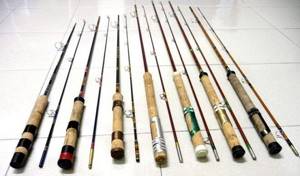
- I will give the well-deserved first place to the Pontoon-21 GAD GANCHO GAN702LLF . The best spinning rod, proven by long practice. A rod originally designed for light and medium jigs can be used for twitching, based on its transitional action. Non-abrasion inserts in the rings and reinforced fastening for the reel are also a plus of the gear, and the main advantage is the price, which will please the experienced spinning connoisseur. The best budget spinning rod is clearly about it.
- Shimano CATANA CX TELESPIN 240 M – for all occasions, of course, fishing. Folding version, lightweight carbon fiber, solid rigidity characteristics. Two hundred and forty centimeters long, they will demonstrate extraordinary fishing abilities on any body of water. The unpleasant thing is the high price, but the reliability and quality of the spinning rod may well outshine it for the owner for long fishing seasons.
- Graphiteleader Tiro Prototype GOTPS-762L-T - will amaze with its elegance and high quality workmanship. Defects in the form, uneven gluing of rings and glue drips cannot be clearly found. The graphite component gives lightness and high sensitivity to the rod tip. The high price factor slightly gives in to the negative, but if funds allow, then it’s certainly not worth skimping on this stick. She will do her job in full. Elite spinning rods are the rank of this representative of the top.
- Shimano EXAGE AX STC TROLLING 30 is a clear favorite among the trolling poles. High power with a relatively short form of 210 m. Four sections clearly provide advantages for transportation both on land and on water. Strong, non-wearable liners in guide rings, which is important for trolling. The average price range has made this spinning rod one of the most common among trollers. Budget spinning rods are its niche in the market.
- Major Craft CROSTAGE CRK-S732AJI is a lightweight spinning rod and an ultra-light king in terms of range. The blank is set to a wide test range of 0.7-10, which is rare for this class of gear, but is an advantage for the universal angler. The ring inserts are made of stainless steel, which will never cause scuffing of the fishing line or braid from oxidation. The cost is average.
- FAVORITE White Bird WB-682UL-S is another ultralight favorite among spinners. Low price, but a successful combination of blank material made of carbon with the final characteristics make this two-meter spinning rod resistant to test overloads, which is sometimes quite important for an ultralight. The sensitivity of the wand slightly suffers from this factor, but otherwise the impressions are excellent.
- Salmo ELITE X-TWITCH 198 is the most budget twitching representative. A two-meter plug with a medium test of 5-25 g makes the stick close to a universal one. The quality of the plug saddle is very decent; backlash, even during multi-season use, is alien to this model. Low price and indestructible in case of operating errors. Definitely a note for beginners.
- Norstream Dynamic F1 DYFS-772MH – twitching direction with quick adjustment to the jig. It is difficult to characterize the 10-38 gram test fork in any other way. A reliable Japanese high-modulus carbon fiber blank and a mid-level price factor have made the stick a common model when hunting for zubat.
- Maximus Wild Power-X SWPX27H is a casting representative of budget fishing rods. Heavy jigs and powerful wobblers when twitching can be easily controlled with a reliable carbon fiber blank. Despite its massiveness, the manufacturer achieved a very modest weight of the fishing rod of only 180 grams. A reliable form, even in the inexperienced hands of a beginner, gives a feeling of reliability and comfort when working.
- Penn Squadron Travel Boat 215 is of particular interest to trolling enthusiasts chasing trophy specimens. Reinforced guide rings together make the form more resistant to extreme test loads. Massiveness and harmony with a lightweight neoprene handle lead to the ideal balance of tackle for trolling hunting. The price factor is within the average level, I can safely say that it is inexpensive.
The presented top 10 spinning rods provide initial coordinates when choosing gear for the type of spinning fishing you cultivate. By comparing the advantages of the presented models with the ones you have in mind, you can find compromise options for purchase, look at an unknown brand of the manufacturer, and then, with an understanding of the matter, purchase the selected spinning rod for use.
